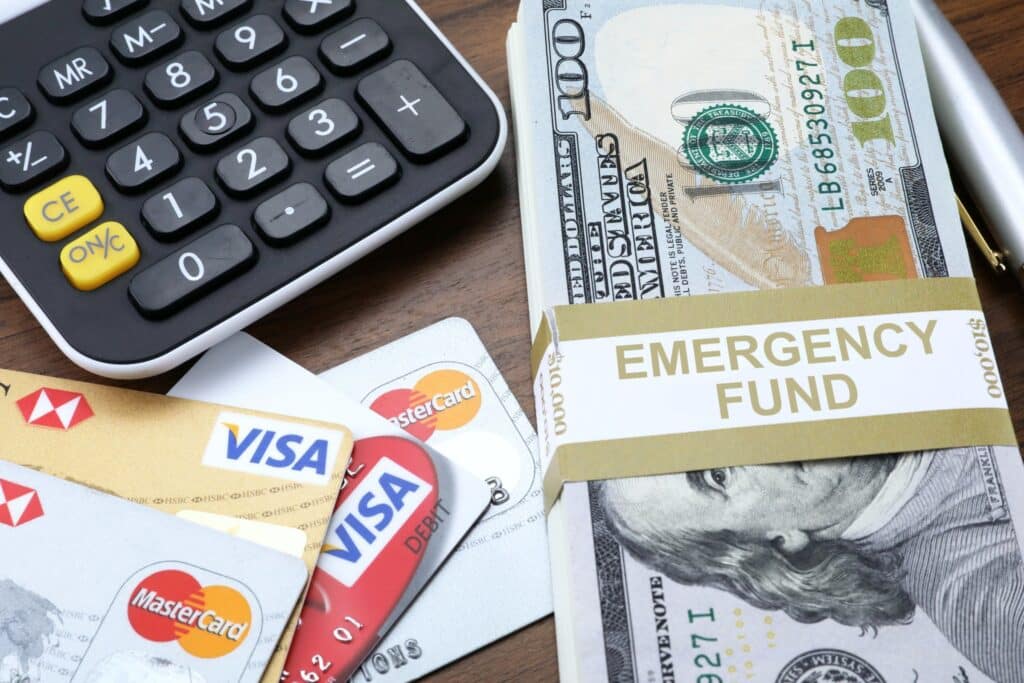Emergency funds and credit cards

Let's dive deep into the world of emergency funds and why having a credit card tucked away might just be your knight in shining armor during unexpected financial hiccups. Ever wondered how you could balance two seemingly different financial tools? You're in the right place!
Understanding the importance of ready cash for unforeseen events is one thing; knowing how to seamlessly integrate credit for those "just in case" scenarios is another. Together, they can create a robust safety net for you or your family.
This blog will take you by the hand and walk you through everything from building your emergency cash reserves to smartly using credit cards as a fallback option - all without the usual financial jargon.
Why emergency funds are your financial safety net
Emergency funds are like that reliable friend you can always count on - there for you when you need it the most, offering peace of mind amidst life's uncertainties. It's that stash of cash meant for, well, emergencies. From job loss to unexpected car repairs, having an emergency fund keeps you from spiraling into a financial panic.
Think of it as your financial pillow, softening the blow from any unforeseen bumps you might encounter along the way. A well-stocked emergency fund ensures that sudden expenses don't derail your finances, allowing you to sleep soundly at night.
But here comes the million-dollar question: How much should you save? The rule of thumb is to have at least three to six months' worth of living expenses tucked away. But remember, the right amount varies depending on your personal circumstances and risk tolerance.
Building this fund takes time and discipline, but don't fret! Starting small is better than not starting at all. Every little bit adds up, and before you know it, you'll have built yourself a solid financial cushion.
Integrating credit cards into your emergency planning
Now, let's talk plastic. Credit cards, when used wisely, can be a fantastic tool in your emergency preparedness arsenal. They offer not only a temporary solution in crunch times but also rewards and purchase protection benefits.
However, it's crucial to use them smartly. Maxing out your cards can lead to a slippery slope of spiraling debt. The key is always to have a repayment plan in place. This way, you leverage the benefits without falling into the debt trap.
For more in-depth strategies, check out How to use credit as a backup plan. It’s a gold mine of information on how to effectively use credit without compromising your financial health.
Remember, the goal is to complement your emergency fund, not replace it. A credit card should be your plan B, ensuring that you always have an ace up your sleeve.
Striking the perfect balance between cash and credit
Balancing your safety net means knowing when to dip into your emergency fund and when to swipe your credit card. It's like a dance, and it takes skill and practice to get it right.
High-interest debt should be avoided at all costs, so if it's a choice between draining your fund completely or putting a manageable expense on your card, opt for the latter. For insights on maintaining this delicate balance, don’t miss Balancing savings and credit for emergencies.
The trick is to replenish what you take out, keeping your safety net intact for future needs. It's a continuous cycle of saving, spending wisely, and paying off debt.
Emergency fund vs. Credit cards vs. Loans
When facing an unexpected financial requirement, weighing your options is key. Each option - be it your fund, credit cards, or loans - comes with its own set of pros and cons.
Credit cards offer immediacy and convenience but can tempt overspending. Loans might offer lower interest rates compared to credit cards but often involve a longer commitment. Understanding these nuances is critical for making informed decisions.
For a deeper dive into this topic, check out Credit cards vs loans for unexpected expenses. It'll give you a clearer picture of when and how to use each option effectively.
{FAQ}
{FAQ_ITEM}
{FAQ_TITULO}What’s the ideal size for an emergency fund?{/FAQ_TITULO}
{FAQ_CONTEUDO}Aim for three to six months' worth of living expenses. However, the "ideal" size varies based on individual lifestyle, income, and expenses.{/FAQ_CONTEUDO}
{/FAQ_ITEM}
{FAQ_ITEM}
{FAQ_TITULO}Can I solely rely on my credit card for emergencies?{/FAQ_TITULO}
{FAQ_CONTEUDO}Using a credit card as your only emergency plan is risky. It's best used as a backup, paired with a solid emergency cash reserve.{/FAQ_CONTEUDO}
{/FAQ_ITEM}
{FAQ_ITEM}
{FAQ_TITULO}How do I balance using cash and credit in emergencies?{/FAQ_TITULO}
{FAQ_CONTEUDO}Assess the situation's urgency and cost. Use credit for immediate, short-term needs while reserving cash for significant, long-term emergencies. Always plan your repayment strategy promptly.{/FAQ_CONTEUDO}
{/FAQ_ITEM}
{/FAQ}
Wrapping it all up
In a nutshell, navigating through life's financial uncertainties requires a bit of planning, a sprinkle of discipline, and a dash of savvy decision-making. By building a robust emergency fund and understanding how to use credit cards wisely, you're not just preparing yourself for the unexpected - you're securing your peace of mind.
Start small, think big, and keep pushing forward. Before you know it, you'll develop a financial resilience that can withstand any storm.
Remember, the journey to financial security doesn't happen overnight. But with each step, you're one step closer to achieving that cozy, stress-free comfort zone where you're ready for just about anything.
So, what are you waiting for? Dive in, start planning today, and turn those emergencies into mere bumps in the road on your journey to financial freedom.

Related